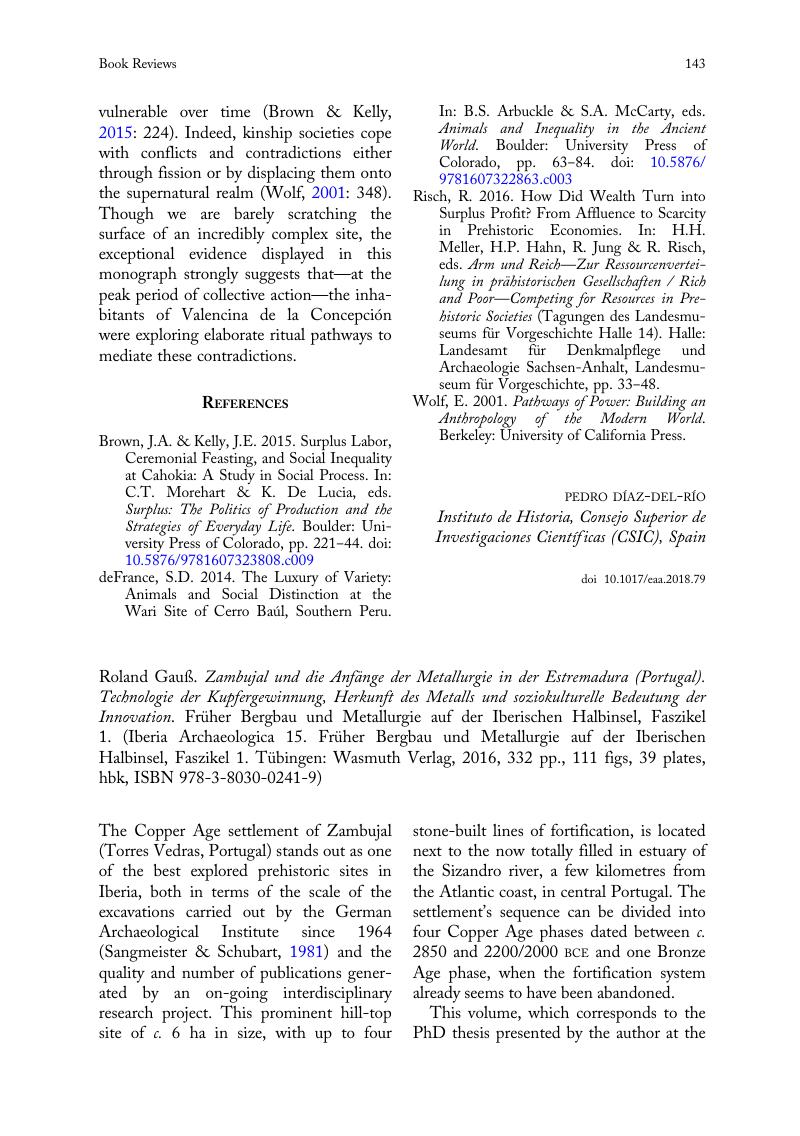No CrossRef data available.
Article contents
Roland Gauß . Zambujal und die Anfänge der Metallurgie in der Estremadura (Portugal). Technologie der Kupfergewinnung, Herkunft des Metalls und soziokulturelle Bedeutung der Innovation. Früher Bergbau und Metallurgie auf der Iberischen Halbinsel, Faszikel 1. (Iberia Archaeologica 15. Früher Bergbau und Metallurgie auf der Iberischen Halbinsel, Faszikel 1. Tübingen: Wasmuth Verlag, 2016, 332 pp., 111 figs, 39 plates, hbk, ISBN 978-3-8030-0241-9)
Review products
Roland Gauß . Zambujal und die Anfänge der Metallurgie in der Estremadura (Portugal). Technologie der Kupfergewinnung, Herkunft des Metalls und soziokulturelle Bedeutung der Innovation. Früher Bergbau und Metallurgie auf der Iberischen Halbinsel, Faszikel 1. (Iberia Archaeologica 15. Früher Bergbau und Metallurgie auf der Iberischen Halbinsel, Faszikel 1. Tübingen: Wasmuth Verlag, 2016, 332 pp., 111 figs, 39 plates, hbk, ISBN 978-3-8030-0241-9)
Published online by Cambridge University Press: 18 January 2018
Abstract
An abstract is not available for this content so a preview has been provided. Please use the Get access link above for information on how to access this content.

- Type
- Book Reviews
- Information
- Copyright
- Copyright © European Association of Archaeologists 2018
References
Escanilla Artigas, N.
2016. Recursos minerales de cobre y su explotación prehistórica en el sudeste peninsular. El valle del Guadalentín. Barcelona: Universitat Autònoma de Barcelona.Google Scholar
Goldenberg, G. & Hanning, E.
in press. Mining Archaeological Prospection for Prehistoric Copper Ore Mining Activities in Portugal (Alentejo and Algarve, 2004‒2007). In: Kunst, M., ed. Kupferzeitliche Metallurgie in Zambujal, in Estremadura, Südportugal und Südwestspanien. Madrid: Madrider Beiträge.Google Scholar
Lull, V., Micó, R., Rihuete, C. & Risch, R.
2010. Metal and Social Relations of Production in the 3rd and 2nd Millennia bc in the Southeast of the Iberian Peninsula. Trabajos de Prehistoria, 67: 232‒47. doi: http://doi.org/10.3989/tp.2010.10042
Google Scholar
Müller, R. & Cardoso, J.L.
2008. The Origin and Use of Copper at the Chalcolithic Fortification of Leceia (Oeiras, Portugal). Madrider Mitteilungen, 49: 64‒93.Google Scholar
Müller, R. & Pernicka, E.
2009. Chemical Analyses in Archaeometallurgy: A View on the Iberian Peninsula. In: Kienlin, T. & Roberts, B., eds. Metals and Societies: Studies in Honour of Barbara Ottaway (Universitätsforschungen zur prähistorischen Archäologie 169). Bonn: Verlag Dr. Rudolf Habelt, pp. 296‒306.Google Scholar
Müller, R. & Soares, A.M.
2008. Traces of Early Copper Production at the Chalcolithic Fortification of Vila Nova de São Pedro (Azambuja, Portugal). Madrider Mitteilungen, 49: 94‒114.Google Scholar
Müller, R., Goldenberg, G., Bartelheim, M., Kunst, M., & Pernicka, E.
2007. Zambujal and the Beginnings of Metallurgy in Southern Portugal. In: La Niece, S., Hook, D., & Craddock, P.T., eds. Metals and Mines: Studies in Archaeometallurgy. London: Archetype Publications, pp. 15–26.Google Scholar
Nocete, F. ed. 2004. Odiel: proyecto de investigación arqueológica para el análisis del origen de la desigualdad social en el suroeste de la Península Ibérica. Sevilla: Consejería de Cultura, Junta de Andalucía.Google Scholar
Sangmeister, E.
1995. Die Kupferfunde aus den Grabungen 1964 bis 1973. In: Sangmeister, E. & Jiménez, M.C., Zambujal: Kupferfunde aus den Grabungen 1964 bis 1973—Los amuletos de las campañas 1964 hasta 1973 (Zambujal Teil 3, Madrider Beiträge 5.3). Mainz: Zabern, pp. 1‒155.Google Scholar
Sangmeister, E. & Schubart, H.
1981. Zambujal: Die Grabungen 1964 bis 1973 (Madrider Beitrage 5). Mainz: Zabern.Google Scholar




